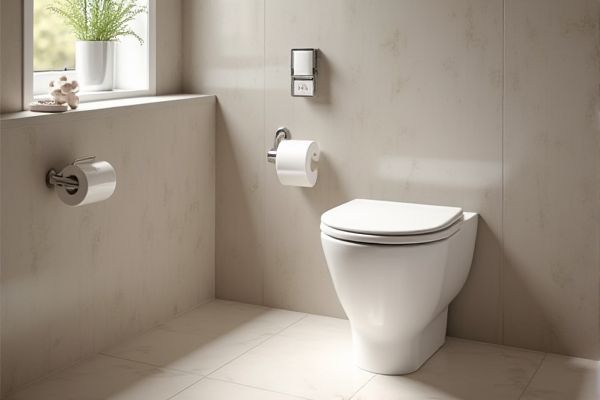
Smart toilets offer advanced features like automated flushing, heated seats, and bidet functions that enhance comfort and hygiene compared to standard toilets, which provide basic flushing and seating. Discover how upgrading to a smart toilet can transform Your bathroom experience by reading the rest of this article.
Table of Comparison
| Feature | Smart Toilet | Standard Toilet |
|---|---|---|
| Functionality | Automated flushing, bidet, heated seat, air dryer, night light | Manual flush, basic seat |
| Water Efficiency | High, with adjustable water pressure and eco modes | Standard flush volume, less water-efficient |
| Hygiene | Self-cleaning nozzles, UV sterilization, touchless operation | Manual cleaning, no automated hygiene features |
| Comfort | Heated seats, customizable settings | Basic seat, no heating |
| Installation | Requires electrical power and professional installation | Simple installation, no electricity needed |
| Price | Higher upfront cost ($500-$3000) | Lower cost ($100-$300) |
| Maintenance | More complex, potential for electronic repairs | Minimal, basic plumbing upkeep |
| Smart Features | App integration, remote control, automatic lid | None |
Introduction: Understanding Smart vs Standard Toilets
Smart toilets feature advanced technologies such as automated flushing, heated seats, and integrated bidet functions, enhancing hygiene and comfort beyond what standard toilets offer. Standard toilets operate with basic flushing mechanisms and manual controls, often lacking customization options and energy-saving features found in smart models. The growing demand for smart toilets is driven by their ability to improve sanitation, conserve water, and provide a more personalized bathroom experience.
Key Features of Smart Toilets
Smart toilets incorporate advanced features like automated flushing, heated seats, bidet functions with adjustable water pressure and temperature, and self-cleaning capabilities using UV light or electrolyzed water. Integrated sensors enable touchless operation, enhancing hygiene and convenience, while air deodorizers and night lights improve user experience. These technologies provide energy-efficient performance and personalized settings, distinguishing smart toilets significantly from standard models.
Key Features of Standard Toilets
Standard toilets feature a basic flushing system designed for water efficiency and effective waste removal, often using gravity or pressure-assisted flush mechanisms. They include a simple bowl and tank structure with manual controls such as a lever or button for flushing. Your choice of standard toilets can prioritize durability, ease of installation, and affordability without advanced electronic components.
Technology and Innovation Comparison
Smart toilets integrate advanced technologies such as automatic flushing, heated seats, built-in bidets, air dryers, and touchless sensors, enhancing hygiene and user comfort compared to standard toilets. They often feature customizable settings, water-saving flush modes, and self-cleaning functions driven by IoT capabilities and AI sensors. In contrast, standard toilets rely on manual operation and lack digital interfaces or adaptive technology, limiting innovation in sanitation and user experience.
Hygiene and Comfort Differences
Smart toilets offer advanced hygiene features such as bidet functions, heated seats, and automatic lid opening, significantly enhancing your comfort and cleanliness compared to standard toilets. Standard toilets rely on manual flushing and wiping, lacking antimicrobial surfaces or personalized settings that adjust temperature and pressure for optimal hygiene. The integration of sensors and self-cleaning technology in smart toilets reduces the risk of germs, making them a superior choice for maintaining bathroom sanitation.
Water Efficiency and Environmental Impact
Smart toilets utilize advanced flushing technologies like dual flush systems and sensor-activated water release, significantly reducing water consumption compared to standard toilets that typically use a fixed water volume per flush. These innovations contribute to lower household water usage, conserving water resources and decreasing environmental impact by minimizing wastewater production. Studies indicate that smart toilets can save up to 30-60% more water annually than traditional models, promoting sustainable water management practices.
Installation and Maintenance Requirements
Smart toilets require more complex installation processes involving electrical connections and potential plumbing upgrades compared to standard toilets, which typically only need basic water supply hookups. Maintenance for smart toilets often includes software updates, sensor cleaning, and occasional repairs to electronic components, whereas standard toilets mainly need periodic flushing mechanism adjustments and leak checks. Your choice should consider the availability of technical support and comfort with handling more advanced maintenance tasks for smart toilets.
Cost Analysis: Upfront and Long-Term Expenses
Smart toilets typically have a higher upfront cost ranging from $500 to $5,000 compared to standard toilets, which usually cost between $100 and $300. Long-term expenses for smart toilets may include maintenance and potential repairs for electronic components, while standard toilets generally incur lower upkeep costs. Your decision should weigh the initial investment against potential water savings and enhanced hygiene features offered by smart toilets.
User Experience and Accessibility
Smart toilets enhance user experience through features like heated seats, adjustable water temperature, automatic lid operation, and customizable cleaning modes, providing superior comfort and hygiene compared to standard toilets. Accessibility is significantly improved with touchless controls, voice activation, and bidet functions that cater to individuals with mobility challenges or disabilities. These innovations promote independence and convenience, surpassing the limitations of conventional toilet designs.
Which Toilet Is Right for You?
Smart toilets offer advanced features such as bidet functions, heated seats, automatic flushing, and air drying, enhancing hygiene and comfort for users seeking a modern bathroom experience. Standard toilets remain a reliable, cost-effective option with simpler installation and maintenance, ideal for budget-conscious households or those prioritizing traditional functionality. Choosing the right toilet depends on personal preferences, budget, and desired technological conveniences in daily bathroom use.
 homyna.com
homyna.com